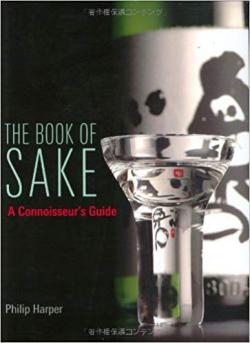The Book of Sake: A Connoisseur’s Guide

Kodansha, 2006, 96 pages including glossary, photographs, ISBN: 9784770029980
Review by William Farr
The growth of sake drinking in the West has gone hand in hand with the growth of books on the subject, as well as the consumption of Japanese food and drink. In the last ten years in particular, and especially within the United States, specialist shops and writers have emerged. The United Kingdom though is lucky enough to have the only non-Japanese Master Brewer in the form of Philip Harper. In “The Book of Sake” Mr. Harper, accompanied by tasting guidance from the esteemed Sake critic Haruo Matsuzaki, puts his knowledge into a well-written tour of the world of sake for the connoisseur. Additionally, having been fortunate enough to meet Mr Harper as recently as October 2008 at a British Sake Association function, his wit, enthusiasm, and energy for Sake is clearly apparent in writing as well as in person. This writer has the utmost respect for all those in the Sake industry who toil through the long cold winter months, the months when the bacteria needed to brew Sake can be best controlled. Mr. Harper not only toiled through many cold winter months over many years but also learnt the complete art of Sake brewing from the hardest and most physically demanding jobs upwards, and so must be applauded all the more for entering the Sake world the hard way. Not only that but the Sake industry is a traditional element of Japanese society and so to break into that world, gain acceptance, and reach the highest standard as a master brewer makes Philip Harper’s views on Sake all the more poignant.
Early chapters in this book – unlike others in the genre – do not swamp the reader with scientific facts and figures on how sake is made. Rather we are drawn into the sake world gradually using a bottom-up approach that focuses on the versatility of sake. Whether sake is chilled and drunk alone, served with food, heated, or imbibed with Fugu-fin (Hire-Sake) the diversity of methods available for the enjoyment of sake is on show. Delicate photography such as the wonderful picture on page 25 show the grades of colour that Sake can possess from clear varieties through to rustic copper coloured versions.
It is particularly heartwarming to read that at Philip Harper’s brewery they are unapologetic as they drink sake by pouring a bottle into a kettle and then proceeding to warm the kettle on a stove. This image may sound very abrupt and basic, but this clear simplicity of personal yet enriched design stands as a hallmark of Mr. Harper’s philosophy of sake. We are positively encouraged to explore, increasing our understanding of subtle Sake flavours in isolation or in relation to food.
At various points in the book green indented boxes reveal a little more of the language of sake from Nihonshudo (sake metre value) to Umami (hearty deliciousness) and so we are gradually educated in the ways of the Sake world. Regional variations are discussed in chapter three, as is the master brewers system of which Mr. Harper is part. The science of Sake brewing is left to the end of the book. What is excellent is that the reader can take from the book snippets of information at leisure, and so gradually build up a view of Sake.
A good glossary, with Sake specifications of top brands, and then a wonderfully indented Brewer’s Notebook on the inside back page made me wish for a pocket version of the book, along the lines of popular Japan Travel Bureau “Japan in Your Pocket” series. The book is well illustrated and all photographs are accompanied by good explanations. Any Sake lover, or any British Sake lover should ideally have this guide on their bookshelf.
Unabashed, clear, always seeking to make the reader think about Sake and in particular why you like it in the way you do this is a refreshing addition to the canon of Western writing on Sake. The overwhelming impression from the book is that however you drink Sake, you will not be judged, as long as you enjoy it. Super Kanpai.

